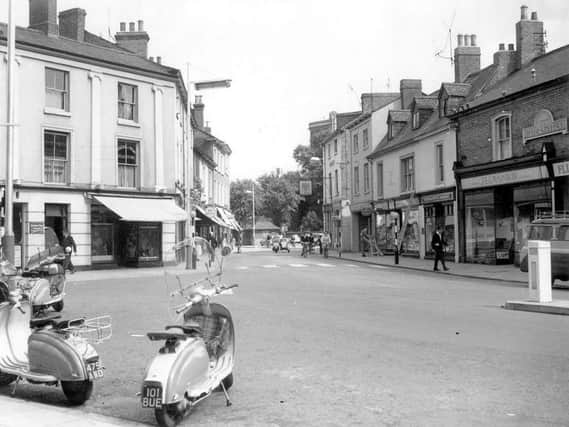Former Advertiser reporter recalls days of climbing onto a Lambretta and hunting for rock musicians at Watford Gap


There they were, lined up like cavalry ponies waiting for the command… those of us who can remember Rugby’s Il Cadore coffee bar in the 1960s will never forget the site of all those scooters.
Vespas, Lambrettas, the occasional NSU Prima… these were the trusty steeds that carried many a cappuccino-fortified owner on journeys far and near from their Chapel Street base.
Advertisement
Hide AdAdvertisement
Hide AdThe generation that grew up after the Second World War had one thing that their predecessors lacked. And that was transport.
They were no longer tied to home town or village, and Rugby youngsters of that era certainly took full advantage of this new freedom.
And this meant previously unheard opportunities for travel. Trips might include Coventry, Banbury, Leicester or Northampton all-night dance venues, or perhaps the expedition of choice might be that short hop to Stratford or Warwick for sunny summer days spent by the Avon.
But there was also another favoured destination. And that was Watford Gap services on the newly-opened M1, the purpose being to ‘people watch’ all the top rock bands of the day filing in for their late night meal.
Advertisement
Hide AdAdvertisement
Hide AdWatford Gap services opened on November 2, 1959, the same day as the M1, making them the oldest motorway services in Britain.
The facilities were originally managed by Blue Boar, a local company that had run a nearby petrol station before the M1 opened. This was called the Blue Boar Garage and Café. It was located on the A5 Watling Street, and there will still be motorcyclists who remember the place.
The Blue Boar Company already owned several petrol stations and cafes in the Northamptonshire and Warwickshire area, but with the planned arrival of the motorway, it was their business at Watford that would suffer most due to the reduced traffic on the A5.
Consequently, the company were offered the opportunity to operate the Watford Gap Motorway Services as compensation. Today, the old Blue Boar Garage and Café site is occupied by a transport depot, which moved to the site in the early 1980s.
Advertisement
Hide AdAdvertisement
Hide AdThe Blue Boar Company was named after the lake behind one of their petrol stations at Dunchurch, where a local legend says that a blue boar lived during the time of Robin Hood.
Roadchef took over the running of the place in 1995.
For many of today’s travellers along the M1, Watford Gap is the chance to refuel, take a break and to use the facilities at the motorway service station.
However, the real Watford Gap is somewhere quite different. It sits at the top of a long rising stretch of the A5, about a mile or so from Watford
village and is marked by a lone agricultural property.
It is here that the original Watford Gap Inn once stood in the 17th and 18th centuries, later to be replaced by farm buildings.
Advertisement
Hide AdAdvertisement
Hide AdThe area was farmed by the Payne family for several generations from around the middle 1760s.
But it was during the rock ‘n’ roll revolution of the 1960s that the service station became the post-gig haunt of the stars of the day.
And that’s why many Rugby youngsters would go ‘group spotting’ in the early hours of a Sunday morning to see who they might observe eating the obligatory fodder of greasy sausage, egg and chips.
Among the celebrity musicians I remember seeing are Rolling Stone Bill Wyman, the Who’s Pete Townsend, Chris Farlowe of the Thunderbirds and Dave Davies of the Kinks.
Advertisement
Hide AdAdvertisement
Hide AdThere were often opportunities for autographs, too. It was the girls who mainly requested these, I seem to remember. I wonder if any of these fading scrawls still exist?
The main building at Watford Gap was designed by Harry Weedon, the architect for Odeon Cinemas, while the layout and general buildings were designed by coordinating architect Owen Williams.
The main building was not ready on opening in 1959, so food was served from temporary sheds. The restaurant opened in September, 1960, but due to the site’s reputation as a truck stop, was redesigned in 1964 to accommodate a waitress service.
And it was then that the services became a meeting place for the chart-topping bands of the day, including the Beatles, Rolling Stones, Pink Floyd and Jimi Hendrix, as it provided a convenient place to sit down and eat a meal in the early hours.
Advertisement
Hide AdAdvertisement
Hide AdHowever, during the 1970s, the quality of the services was regarded by many as having declined, and the food came in for harsh criticism from journalists and artists. But since its purchase in 1995, Roadchef has completely refurbished the premises.
The company has also promoted the history, including its regular use by 1960s rock musicians. And a number of events took place to celebrate the 50th anniversary in November, 2009, including the staging of a musical.
Fame indeed. But what I’ll always really remember was when there came that ripple of conversation late at night at ‘The Ilk’ which soon turned into the rallying cry of “Hey, let’s go down to Watford Gap and spot some groups!”
John Phillpott’s third book titled Go and Make the Tea, Boy! is on sale now, published by Brewin Books.